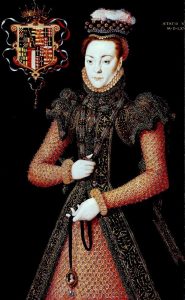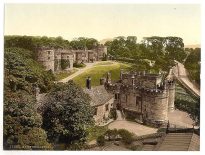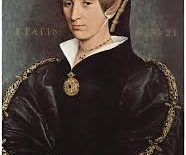 A recent BBC Four documentary examined the tragic life of England's Forgotten Queen, Lady Jane Grey, who was proclaimed queen in July 1553 and beheaded seven months later for unlawfully usurping the throne from Mary I. The circumstances in which Jane succeeded her cousin Edward VI derived in part from Henry VIII's Acts of Succession (1536 and 1544) and his last will and testament, which was finalised a month before his death. After stipulating that his crown should pass to Edward, Henry intended that his daughters Mary and Elizabeth would successively reign in the event of Edward dying childless. Henry also instructed that the descendants of his younger sister Mary should inherit the throne if all three of his children died without heirs: thus Mary's daughters Frances and Eleanor and their offspring. Lady Jane Grey was, of course, the eldest daughter of Frances. Her two sisters Katherine and Mary would represent a rival succession in Elizabeth I's reign, and the Tudor queen imprisoned both women on account of what she perceived as their dynastic pretensions. As a result of his Acts and his will, Henry made it possible for the monarch to appoint their successor based on personal preferences. Edward took this one step further in 1553 by disregarding the claims of his half-sisters Mary and Elizabeth, and instead nominating the Grey line.
A recent BBC Four documentary examined the tragic life of England's Forgotten Queen, Lady Jane Grey, who was proclaimed queen in July 1553 and beheaded seven months later for unlawfully usurping the throne from Mary I. The circumstances in which Jane succeeded her cousin Edward VI derived in part from Henry VIII's Acts of Succession (1536 and 1544) and his last will and testament, which was finalised a month before his death. After stipulating that his crown should pass to Edward, Henry intended that his daughters Mary and Elizabeth would successively reign in the event of Edward dying childless. Henry also instructed that the descendants of his younger sister Mary should inherit the throne if all three of his children died without heirs: thus Mary's daughters Frances and Eleanor and their offspring. Lady Jane Grey was, of course, the eldest daughter of Frances. Her two sisters Katherine and Mary would represent a rival succession in Elizabeth I's reign, and the Tudor queen imprisoned both women on account of what she perceived as their dynastic pretensions. As a result of his Acts and his will, Henry made it possible for the monarch to appoint their successor based on personal preferences. Edward took this one step further in 1553 by disregarding the claims of his half-sisters Mary and Elizabeth, and instead nominating the Grey line.
Lady Jane and her sisters are well known, for they have been extensively written about in both fiction and non-fiction. Their cousin Margaret Clifford, Countess of Derby, is however far less well known. Like the Grey sisters, Margaret was a granddaughter of Mary Tudor, Queen of France and Duchess of Suffolk, and a great-granddaughter of Henry VII, the first Tudor king. Margaret was the daughter of Henry Clifford, Earl of Cumberland and his wife Eleanor Brandon, and was born in 1540, probably at Skipton Castle in North Yorkshire. Eleanor, the younger daughter of Mary Tudor, is a shadowy figure. Only one of her letters survives, in which she addressed her husband as ‘dear heart’ and ‘your assured loving wife’. The couple had three children together: Margaret, Henry and Charles; both sons died in infancy. Margaret’s historical importance lies in her claim to the English throne. Upon the death of her mother on 27 September 1547, eight months after Henry VIII’s death, Margaret became seventh in line to the throne.
Little is known of Margaret’s childhood. She was probably raised at the family seat at Skipton Castle. Her father was a member of the respected northern Clifford family. The Cliffords had traditionally held extensive landholdings in northern England, including Yorkshire and Westmorland. It is unknown whether Henry Clifford’s Catholic faith was shared by his wife Eleanor; certainly, her elder sister had married into a family that favoured the radical Protestantism of Edward VI’s reign. In Elizabeth I’s reign, Henry Clifford was accused of protecting popish priests in the north, and he appears to have promised support to the rebellion of 1569. In 1552, when she was twelve years of age, Margaret was proposed as a bride for Guildford Dudley, a younger son of the Duke of Northumberland, with the support of Edward VI, but Henry Clifford was not in favour of the proposed match. David Loades has suggested that ‘the fact that he [Northumberland] had preferred the Cliffords to the Greys demonstrates that his plans were unconnected with the succession issue.’ Instead, Guildford married Margaret’s cousin Jane Grey. The following year, the Imperial ambassador reported that Margaret would marry Andrew Dudley, the younger brother of the Duke of Northumberland. He was about thirty-three years her senior, which was not unusual in sixteenth-century noble matchmaking. Dudley appears to have intended to go through with the marriage, and in readiness for it, he reserved items from the wardrobe at Westminster including jewels, silver and gilt cups, a hairbrush, velvet dog collars and pictures. However, the mooted Dudley-Clifford wedding did not take place, and Andrew was imprisoned in the Tower of London alongside his brother and nephews for his involvement in the attempt to install Jane Grey as queen. Northumberland was executed in August 1553, but Andrew Dudley was pardoned, and he was released in 1555.
In February 1555, the fifteen-year-old Margaret married Henry Stanley, Earl of Derby, at the chapel royal at Whitehall Palace. He was nine years her senior and was related by blood to the Howard dukes of Norfolk. He had attended Edward VI’s coronation and served as a gentleman of the privy chamber. Unlike Margaret’s father, Stanley was committed to the Protestant faith as a result of his upbringing at Edward VI’s court. The couple do not appear to have enjoyed a happy marriage, and they eventually separated. Despite this, they had four children in the course of their marriage: Edward, Ferdinando, William and Francis. Edward and Francis both died young; Ferdinando and William were successively earls of Derby.
A historical tradition claims that Margaret Clifford had aspirations towards the English throne. In 1568, her cousin Katherine Grey died in disgrace at c*ckfield Hall and another cousin, Mary Grey, died in London in 1578. As a result, by 1579, Margaret was heir to the throne according to the terms of Henry VIII’s last will and testament and the Acts of Succession. This claim was ignored by supporters of the imprisoned Mary, Queen of Scots, who believed that the Stuart line (deriving from Henry VIII’s elder sister) was superior to the Suffolk line (deriving from his younger sister). In 1579, Margaret was accused of employing a magician, Dr Randall, to cast spells that would harm her cousin Queen Elizabeth. Randall was hanged, and Margaret was placed under house arrest. Unlike her husband, Margaret was suspected of harbouring Catholic sympathies, which was a dangerous position to take in the late 1570s. Margaret wrote to the queen, complaining that she was in a ‘black dungeon of sorrow and despair… overwhelmed with heaviness through the loss of your majesty’s favour and gracious countenance.’ Unfortunately for Margaret, she was never restored to favour. She died on 28 September 1596 at the age of fifty-six.
Margaret Clifford is one of the forgotten members of the famous Tudor dynasty. Although her cousins Jane, Katherine and Mary Grey are well-known today, Margaret has been neglected by historians and novelists. Yet, like her more celebrated cousins, Margaret was disgraced and imprisoned by Elizabeth I for allegedly harbouring dynastic pretensions. Her son Ferdinando had predeceased her in 1594, and the earldom of Derby was inherited by her younger son William. After Margaret’s death, her granddaughter Anne Stanley, eldest daughter of Ferdinando, was next in line to Elizabeth’s throne. The queen had barred the descendants of Katherine Grey from inheriting the throne on account of Katherine’s unlawful marriage to Edward Seymour, Earl of Hertford. Neither Jane nor Mary Grey produced children. As a result, according to Henry VIII’s last will and testament, the crown of England should have passed to Anne Stanley on the death of Elizabeth I in 1603. Instead, like her brother Edward, Elizabeth ignored her father’s will. While both Henry VIII and Edward VI had favoured the line represented by Mary Tudor, Duchess of Suffolk, Elizabeth’s preference was for the line deriving from Margaret Tudor, Queen of Scotland. Thus, on her death, the crown passed not to Anne Stanley but to James VI of Scotland, the son of Mary Queen of Scots and the great-grandson of Margaret Tudor.
Conor Byrne studied at the universities of Exeter and York. He specialises in late medieval and early modern English history, with an emphasis on royal history, gender relations and Tudor queenship. His first book, Katherine Howard: A New History (2014) was published by MadeGlobal and has been described as ‘a brilliant study’, ‘a new and refreshing biography of Katherine Howard’ and ‘a timely addition to Tudor scholarship’. Conor’s second book Queenship in England (2017) was also published by MadeGlobal and provides an in-depth analysis of fourteenth- and fifteenth-century queenship. He runs an active Facebook page at www.facebook.com/ConorByrneHistorian.
Picture: Portrait of an unknown woman, thought to be either Margaret Clifford, Countess of Derby, or her mother Eleanor Brandon, Countess of Cumberland.



Leave a Reply